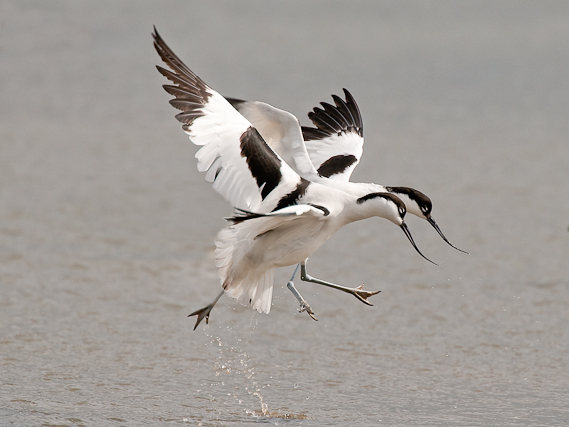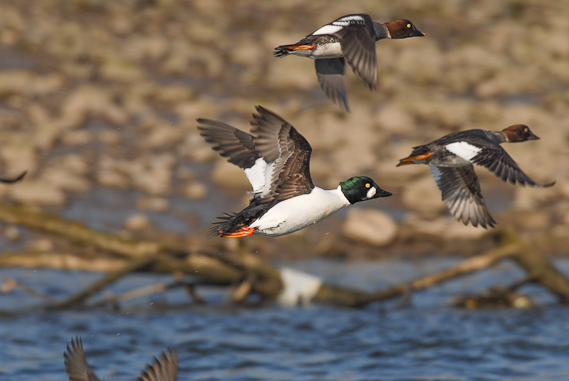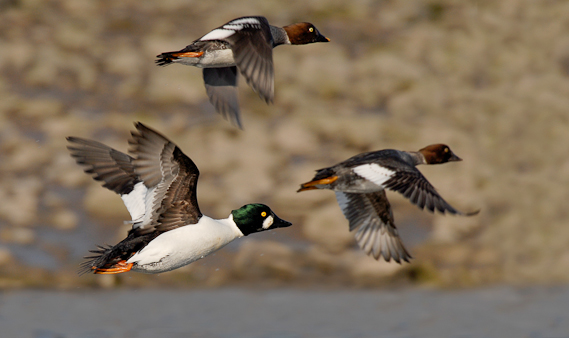Surely a case of crossing the line with this construction of an egret and a frog by Bryan Patrick.
Some interesting comments from the previous post and as I mentioned in my last comment to Joyce, there is a line that perhaps defines what is acceptable in the removal of distracting elements, maybe the image above helps to clarify where that line sits.
What’s acceptable?
But just how much ‘doctoring’ of an image is justified? The removal of a twig that breaks the bird may be ok, but what about the removal of a log or of another bird that is distracting?
Two images showing significant alterations
Here are two sets of images that further the debate and perhaps begin to question where that elusive line may lie. The first image in each case is the original unedited image, the second has been ‘tampered’ with. Where do we stand with these two images?
The avocets have a bird in the background that uncomfortably brakes the outline of the two birds leaping and a further distracting bird on the right.
The goldeneyes have a very messy foreground and not enough ‘empty space’ for the birds to fly into.
Both images have what could be classed as a significant alterations, they are both undoubtedly stronger for the removal of distracting elements and, in the case of the goldeneyes, the addition of ‘empty space’, but are we now crossing that elusive line of acceptable alterations?
The compression of time
Bryan Patrick was suspended for the spliced photograph of an egret eating a frog and this is surely a case where that line has been crossed. The main point here is that the image manipulation brings two separate moments of time together and presents them as one.
Maybe it is the compression of time and the bringing together of two seperate images that is the key? Surely that’s unethical and unacceptable. In both the images that I’ve altered, the event I photographed occurred and in real time, what got in the way did not alter the event or change relative time.
The final image of the egret also has double elements within it. Look at the grasses, the same stalks appear twice, it feels wrong – it hasn’t actually been done well, but that’s not the point. The issue is the deception of two moments portrayed as one.
Your views
Anyway, once again it would be good to hear your views!





If a photography is improved or made stronger then I am all for manipulation of an image and do not mind, however if you are going to enter the image into a competition you need to stick to the rules they have set out. Some say if it cannot be done in a darkroom then it should not be allowed but I know skilled photographers who can take mulitple photographs and put them together in the darkroom so what is the difference with Bryan Patrick splicing in the frog apart from it is easier with digital.
I don’t think this argument will ever be settled as it has rumbled on now within camera club and on competitions since digital age started and image manipulation was made more available.
I say get with it and use what technology is there BUT be honest and declare what you have done.
Good to hear from you Neil. It’s probably never going to be settled as you say. Interested to know from you what the rules of the camera club competitions are. If someone is submitting a wildlife image, is combining more than one image acceptable or will it vary from club to club or even competition to competition?
It’s an interesting one because if you delve back into the history of photography there are many examples of combination images, sometimes due to the limitations of the film being able to record blue sky. The only way to produce an acceptable representation of the scene, with sky and foreground, was to combine two separate negatives (Gustave Le-Gray). Others, Pictorialists, combined negatives (sometimes a considerable number) because they felt that as photography should be considered a ‘fine art’ they could approach their subject as an artist would approach a canvas. Combining sitters and sets and building up an image from multiple sources was a natural extension of seeing photography as an art. (Oscar Rejlander and Henry Peach Robinson). In these cases all the manipulation was done in a darkroom, so as you say the adage, ‘if it can’t be done in a darkroom then don’t do it’ doesn’t seem to apply.
Once ‘Straight’ photography had challenged the validity of Pictorialism the question of integrity of the image representing a single moment became key.
‘Art’ photography still has a strong place within the medium and holds values that were once the domain of the Pictorialists and within this genre there can be no question that manipulation is totally acceptable. However, in the likes of reportage and documentary photography it can have no place. With these points in mind we need to establish whether natural history photography is art or documentary – and here’s the problem, it can be both!
I think that in the end it becomes important to do as you state and be honest about what you have done. An abbreviation system could be established that clearly identifies the parameters you have worked within.
Hi Tim!
This is such an interesting debate and one that I know we’ve discussed several times with wildlife and in your Documentary classes. For me the line is drawn mainly in the latter. If the image is intended to document a moment or to be published as a trusted and accurate depiction of an event then the photographer should stay as true to the moment as possible (minus standard digital darkroom adjustments).
I recently took an image of a male Redshank displaying whilst the female looked away almost bored. I loved the image that I could see! I took several shots as the display went on and was frustrated that another Redshank was walking right through the scene! By the time the 3rd bird had gone, the light had changed and my camera slowed the shutter down so that the flapping wings became blurred. The scene had ended before I could rectify my mistake. I was therefore left with only one image that represented what I had envisioned – with the added unfortunate ‘bonus’ of a few extra tale feathers interrupting the scene. As with your fantastic shot of the Avocets, Photoshop gave a cure.
I agree that we should be allowed to use the technology available as long as we are honest about doing so and that it is done for artistic merit and not as a means to change the real.
PS. do you mind me asking where the Avocets were taken? They really are such a beautifully elegant bird and you’ve captured an incredible moment! :)
Hi Tom,
The Avocets were taken at an RSPB reserve called Marshside just north of Southport. It’s a great place with around 20 pairs nesting there now. The first pairs only nested in 2000 so it’s a bit of a success story. You can get really close to the birds here and in a post coming up shortly I’ll be showing more that I took there in the last couple of weeks. You should try and get up there if you can because very close to it is the Ainsdale nature reserve at Formby point, the best place I know of for getting the red squirrels. I was there recently and they have recovered well from the squirrel pox carried by the grey that devastated the population over the last years (post to follow soon)
Thanks for the comment as well, always interested to hear what folk think. How’s the peregrines this year?
Hi Tim! Thank you so much! I will definitely look into getting up there at some point! There were a few wild Avocet’s at Slimbridge when I was last there (from the Rushy Hide) but they didn’t stray very close!
Oh thanks for the tip on the squirrels! I look forward to your post!! I have found a few locations including a Red Squirrel sanctuary in Dundee (the only place where there are urban reds supposedly!) where I am hoping to spend a week or so. (Shall pitch more ideas to you in Sept!)
The peregrines are unfortunately non existent at the moment. My mum had a phone call from Ed Drewitt asking about them as he is currently writing a book on urban peregrines – so I’m on the look out in order to respond to him too! I can only assume and hope that they are still nesting in the quarry near by and are waiting for the chicks to fledge before coming over the hill to use the church as a hunting ground. My eyes are peeled!